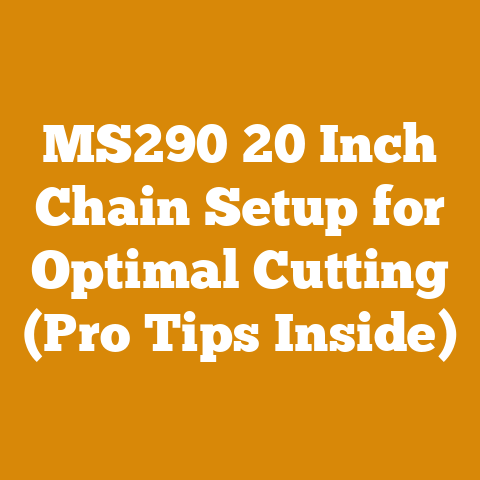Helicoil Thread Repair Kits Review (Essential Fixes for Chainsaws)
The Case of the Stripped Chainsaw Threads: My Helicoil Rescue Mission
Let’s face it, we’ve all been there. You’re deep into a project – maybe felling a stubborn oak, or dismantling a neglected chainsaw for a much-needed overhaul – when disaster strikes. A bolt seizes, a thread strips, and suddenly your progress grinds to a halt. The frustration is palpable, especially when you know that a seemingly minor issue can sideline a valuable piece of equipment, potentially costing you time and money.
I remember one particularly challenging instance a few years back. I was restoring an old Stihl 031AV, a real workhorse from the 70s. The saw was in decent shape overall, but the threads for the muffler bolts were completely shot. Someone had clearly over-tightened them in the past, and the soft aluminum casing had given way. I could have taken it to a shop, but the nearest one specializing in vintage saws was a considerable drive away and frankly, I enjoy tackling these challenges myself. This is where the Helicoil thread repair kit entered the picture, becoming my knight in shining armor.
Understanding Thread Damage in Chainsaws: A Preventative Approach
Before we jump into the repair process, it’s crucial to understand why threads strip in the first place. Chainsaws, by their very nature, are subjected to harsh conditions: vibration, heat, and constant exposure to debris. These factors contribute to thread wear and tear, making them vulnerable to damage.
The Anatomy of a Thread
A thread, at its most basic, is a helical ridge wrapped around a cylinder. In a bolt and nut (or threaded hole) connection, these ridges interlock, creating a strong clamping force. The strength of this connection depends on several factors, including:
- Material: The type of metal used for the bolt and the threaded component. Softer metals like aluminum are more prone to stripping than harder metals like steel.
- Thread Pitch: The distance between adjacent threads. A finer pitch provides more contact area and a stronger hold, but is also more susceptible to cross-threading.
- Thread Depth: The depth of the thread engagement. Insufficient engagement can lead to premature failure.
- Torque: The amount of rotational force applied to the bolt. Over-tightening is a common cause of thread stripping.
Common Causes of Thread Damage in Chainsaws
Several factors can lead to thread damage in chainsaws:
- Over-Tightening: This is the most frequent culprit. Applying excessive torque stretches the threads beyond their yield strength, causing them to deform and eventually strip. Think of it like bending a paperclip back and forth – eventually, it breaks.
- Cross-Threading: Forcing a bolt into a threaded hole at an angle can damage the threads on both the bolt and the component. This is especially common when working in tight spaces or when rushing the job.
- Corrosion: Rust and other forms of corrosion can weaken threads, making them more susceptible to damage.
- Vibration: The constant vibration of a chainsaw can loosen bolts over time. If left unchecked, this can lead to thread wear and eventual stripping.
- Material Compatibility: Using bolts made of different metals can lead to galvanic corrosion, which can weaken threads. For example, using a steel bolt in an aluminum casing can accelerate corrosion.
- Lack of Lubrication: Dry threads create more friction when tightened, increasing the risk of stripping.
Preventing Thread Damage: A Proactive Strategy
Prevention is always better than cure. Here are some tips to minimize the risk of thread damage in your chainsaw:
- Use a Torque Wrench: Invest in a good quality torque wrench and use it whenever tightening bolts, especially those on critical components like the cylinder head or muffler. Consult your chainsaw’s service manual for the correct torque specifications.
- Lubricate Threads: Apply a small amount of anti-seize compound or grease to the threads before tightening bolts. This reduces friction and ensures a more accurate torque reading.
- Start Bolts by Hand: Always start bolts by hand to avoid cross-threading. If you feel any resistance, stop and realign the bolt.
- Check Bolt Tightness Regularly: Periodically check the tightness of bolts, especially after prolonged use. Vibration can cause them to loosen over time.
- Use the Correct Bolts: Ensure you are using the correct bolts for the application. Refer to your chainsaw’s parts diagram or service manual.
- Clean Threads: Before installing a bolt, clean the threads with a wire brush or thread chaser to remove any debris or corrosion.
- Avoid Over-Tightening: Resist the urge to over-tighten bolts. A slightly loose bolt is better than a stripped thread.
By following these preventative measures, you can significantly reduce the risk of thread damage and prolong the life of your chainsaw.
Helicoil Thread Repair Kits: The Basics
Now that we understand the causes of thread damage and how to prevent it, let’s dive into the solution: Helicoil thread repair kits. These kits provide a cost-effective and reliable way to repair stripped threads in various materials, including aluminum, steel, and cast iron.
What is a Helicoil?
A Helicoil, also known as a wire thread insert, is a precision-formed helical coil of stainless steel wire. When installed into a tapped hole, it provides a stronger, more durable thread than the original material. The Helicoil essentially creates a hardened steel thread within the softer base material, offering superior resistance to wear and tear.
How Helicoils Work
The Helicoil works by distributing the load over a larger area of the base material. The coil’s helical shape allows it to expand and contract slightly, providing a more even distribution of stress. This reduces the risk of thread stripping and improves the overall strength of the connection.
Components of a Helicoil Thread Repair Kit
A typical Helicoil thread repair kit includes the following components:
- Drill Bit: Used to enlarge the damaged hole to the correct size for the Helicoil tap.
- Tap: A special tap designed to cut the threads for the Helicoil insert.
- Installation Tool: Used to install the Helicoil insert into the tapped hole.
- Tang Break-Off Tool: Used to break off the tang (a small piece of metal at the end of the insert) after installation.
- Helicoil Inserts: The stainless steel coils that form the new threads.
- Instructions: A detailed instruction manual outlining the repair process.
Types of Helicoil Kits
Helicoil kits are available in various sizes and configurations to suit different applications. Some common types include:
- Standard Helicoil Kits: These kits are designed for general-purpose thread repair and are available in a wide range of sizes.
- Oversized Helicoil Kits: These kits are used when the original hole is too damaged to be repaired with a standard Helicoil.
- Spark Plug Helicoil Kits: These kits are specifically designed for repairing damaged spark plug threads in engine cylinder heads.
- Metric and Imperial Kits: Helicoil kits are available in both metric and imperial thread sizes to accommodate different bolt standards.
When selecting a Helicoil kit, it’s essential to choose the correct size and type for your application. Consult your chainsaw’s service manual or measure the bolt diameter and thread pitch to determine the appropriate kit.
Benefits of Using Helicoil Thread Repair Kits
Using Helicoil thread repair kits offers several advantages over other thread repair methods, such as tapping the hole to a larger size or using thread-forming inserts:
- Increased Thread Strength: Helicoils provide a stronger, more durable thread than the original material.
- Improved Wear Resistance: The stainless steel construction of the Helicoil offers excellent resistance to wear and tear.
- Corrosion Resistance: Helicoils are resistant to corrosion, ensuring a long-lasting repair.
- Cost-Effective: Helicoil kits are a relatively inexpensive way to repair damaged threads, especially compared to replacing the entire component.
- Easy to Use: With a little practice, Helicoil kits are easy to use and can be used by anyone with basic mechanical skills.
- Versatile: Helicoil kits can be used to repair threads in a variety of materials, including aluminum, steel, and cast iron.
- Restores Original Thread Size: Unlike tapping to a larger size, Helicoils allow you to restore the original thread size, so you can use the same bolts.
Selecting the Right Helicoil Kit for Your Chainsaw
Choosing the right Helicoil kit is crucial for a successful thread repair. Here’s a step-by-step guide to help you select the appropriate kit for your chainsaw:
1. Identify the Thread Size
The first step is to identify the thread size of the damaged hole. This information can usually be found in your chainsaw’s service manual or parts diagram. If you don’t have access to these resources, you can measure the bolt diameter and thread pitch using a caliper and thread gauge.
- Diameter: Measure the outside diameter of the bolt threads. This will give you the nominal thread size (e.g., 6mm, 8mm, 1/4 inch, 5/16 inch).
- Thread Pitch: Measure the distance between adjacent threads. This is typically expressed in millimeters for metric threads (e.g., 1.0mm, 1.25mm) or threads per inch for imperial threads (e.g., 20 TPI, 24 TPI).
Once you have determined the thread size, you can search for a Helicoil kit that matches these specifications.
2. Determine the Thread Type
Chainsaws typically use either metric or imperial threads. Ensure that you select a Helicoil kit that matches the thread type of your chainsaw. Metric threads are designated with an “M” followed by the diameter and pitch (e.g., M6 x 1.0). Imperial threads are designated with the diameter, threads per inch, and thread form (e.g., 1/4-20 UNC).
3. Consider the Material of the Component
The material of the component being repaired can also influence your choice of Helicoil kit. For example, if you are repairing threads in a soft aluminum casing, you may want to choose a Helicoil kit with a longer insert to provide more thread engagement and a stronger hold.
4. Choose a Reputable Brand
Stick with reputable brands like Helicoil, Recoil, or V-Coil. These brands are known for their quality and reliability. Avoid generic or off-brand kits, as they may not meet the same standards.
5. Read Reviews
Before purchasing a Helicoil kit, read reviews from other users to get an idea of its quality and ease of use. Pay attention to reviews that mention specific applications similar to yours.
6. Check the Kit Contents
Ensure that the Helicoil kit includes all the necessary components, including the drill bit, tap, installation tool, tang break-off tool, and Helicoil inserts. Some kits may also include additional items, such as cutting oil or a thread chaser.
Example Scenarios
Here are a few example scenarios to illustrate how to select the right Helicoil kit:
- Scenario 1: You need to repair a stripped M6 x 1.0 thread in the aluminum casing of your chainsaw’s carburetor. You would select a metric Helicoil kit that includes an M6 x 1.0 drill bit, tap, installation tool, tang break-off tool, and M6 x 1.0 Helicoil inserts.
- Scenario 2: You need to repair a stripped 1/4-20 UNC thread in the steel frame of your chainsaw. You would select an imperial Helicoil kit that includes a 1/4-20 UNC drill bit, tap, installation tool, tang break-off tool, and 1/4-20 UNC Helicoil inserts.
- Scenario 3: You need to repair a stripped spark plug thread in the aluminum cylinder head of your chainsaw. You would select a spark plug Helicoil kit that is specifically designed for this application.
By following these guidelines, you can confidently select the right Helicoil kit for your chainsaw and ensure a successful thread repair.
Step-by-Step Guide to Using a Helicoil Thread Repair Kit
Now that you have selected the right Helicoil kit, it’s time to get to work. Here’s a step-by-step guide to using a Helicoil thread repair kit:
1. Preparation
- Safety First: Wear safety glasses and gloves to protect your eyes and hands.
- Clean the Area: Thoroughly clean the area around the damaged hole to remove any dirt, debris, or oil.
- Secure the Component: Secure the component in a vise or clamp to prevent it from moving during the repair process.
- Consult the Instructions: Read the instructions that came with your Helicoil kit carefully before starting.
2. Drilling
- Select the Correct Drill Bit: Choose the drill bit that came with your Helicoil kit. It will be the correct size for the Helicoil tap.
- Drill the Hole: Carefully drill out the damaged hole using the drill bit. Keep the drill bit perpendicular to the surface of the component. Apply cutting oil to the drill bit to reduce friction and heat. Drill all the way through the hole, if possible.
- Deburr the Hole: Use a deburring tool or a countersink to remove any burrs or sharp edges from the hole.
3. Tapping
- Select the Correct Tap: Choose the tap that came with your Helicoil kit. It will be the correct size for the Helicoil insert.
- Lubricate the Tap: Apply cutting oil to the tap to reduce friction and heat.
- Tap the Hole: Carefully tap the hole using the tap. Keep the tap perpendicular to the surface of the component. Apply even pressure and turn the tap slowly. Back the tap out periodically to clear any chips. Tap all the way through the hole, if possible.
- Clean the Threads: Use compressed air or a brush to clean any chips or debris from the threads.
4. Installing the Helicoil Insert
- Select the Correct Insert: Choose the Helicoil insert that came with your kit.
- Install the Insert: Place the Helicoil insert onto the installation tool. Align the tang of the insert with the slot in the installation tool.
- Thread the Insert: Carefully thread the Helicoil insert into the tapped hole using the installation tool. Turn the tool clockwise until the insert is fully seated. The top coil of the insert should be slightly below the surface of the component.
- Remove the Installation Tool: Remove the installation tool from the Helicoil insert.
5. Breaking Off the Tang
- Select the Correct Tool: Choose the tang break-off tool that came with your Helicoil kit.
- Break Off the Tang: Place the tang break-off tool onto the tang of the Helicoil insert. Strike the tool with a hammer to break off the tang.
- Remove the Tang: Use a pair of pliers or a magnet to remove the broken-off tang from the hole.
6. Finishing Touches
- Clean the Threads: Use compressed air or a brush to clean any remaining debris from the threads.
- Install the Bolt: Install the bolt into the repaired thread. Tighten the bolt to the correct torque specification.
Tips for Success
- Use Cutting Oil: Applying cutting oil to the drill bit and tap will reduce friction and heat, making the drilling and tapping process easier.
- Keep Everything Perpendicular: Ensure that the drill bit, tap, and installation tool are perpendicular to the surface of the component. This will help to ensure that the threads are straight and accurate.
- Apply Even Pressure: Apply even pressure when drilling and tapping. Avoid forcing the drill bit or tap, as this can damage the threads.
- Back Out the Tap Periodically: Backing out the tap periodically will help to clear any chips and prevent the tap from binding.
- Don’t Over-Tighten: Avoid over-tightening the bolt, as this can damage the Helicoil insert. Use a torque wrench to ensure that the bolt is tightened to the correct specification.
Advanced Techniques and Troubleshooting
While the basic Helicoil installation process is straightforward, there are some advanced techniques and troubleshooting tips that can help you achieve even better results.
Dealing with Damaged or Oversized Holes
Sometimes, the damaged hole may be too large or irregular to be repaired with a standard Helicoil kit. In these cases, you may need to use an oversized Helicoil kit or employ some additional techniques to prepare the hole.
- Oversized Helicoil Kits: These kits include larger drill bits and taps that are designed to create a larger hole for the Helicoil insert. This can be useful if the original hole has been significantly damaged or enlarged.
- Welding: If the hole is too large or irregular, you may need to weld the hole closed and then drill and tap a new hole. This is a more advanced technique that requires welding experience.
- Epoxy Fill: In some cases, you can fill the damaged hole with epoxy and then drill and tap a new hole. This is a less durable option than welding, but it can be effective for non-critical applications.
Ensuring Proper Thread Alignment
Proper thread alignment is crucial for a successful Helicoil repair. If the threads are not aligned correctly, the bolt may be difficult to install, and the connection may be weak.
- Use a Drill Press: If possible, use a drill press to ensure that the drill bit is perpendicular to the surface of the component.
- Use a Tap Guide: A tap guide can help to keep the tap perpendicular to the surface of the component.
- Check Thread Alignment: After tapping the hole, check the thread alignment using a thread gauge or a bolt. If the threads are not aligned correctly, you may need to re-tap the hole.
Removing Broken Helicoil Inserts
Occasionally, a Helicoil insert may break during installation or removal. Removing a broken Helicoil insert can be challenging, but it is possible with the right tools and techniques.
- Use a Screw Extractor: A screw extractor can be used to remove a broken Helicoil insert. Drill a small hole into the center of the broken insert and then insert the screw extractor. Turn the screw extractor counterclockwise to remove the insert.
- Use a Pick or Awl: A pick or awl can be used to carefully pry the broken insert out of the hole.
- Use Heat: Applying heat to the component can help to loosen the broken insert and make it easier to remove.
Preventing Future Thread Damage
After repairing a damaged thread with a Helicoil kit, it’s important to take steps to prevent future thread damage.
- Use a Torque Wrench: Always use a torque wrench to tighten bolts to the correct specification.
- Lubricate Threads: Apply a small amount of anti-seize compound or grease to the threads before tightening bolts.
- Check Bolt Tightness Regularly: Periodically check the tightness of bolts, especially after prolonged use.
- Use the Correct Bolts: Ensure that you are using the correct bolts for the application.
Real-World Examples: Helicoil Repairs in Action
Let’s look at some real-world examples of how Helicoil thread repair kits can be used to fix common problems in chainsaws and other wood processing equipment.
Case Study 1: Muffler Bolt Repair on a Stihl 026
As I mentioned earlier, I used a Helicoil kit to repair the stripped muffler bolt threads on my old Stihl 031AV. The process was straightforward, and the repair has held up well over the years. The key was to carefully drill and tap the hole, ensuring that the threads were aligned correctly.
A similar situation arose with a Stihl 026 I was servicing for a friend. The muffler bolts had been over-tightened, and the threads in the aluminum cylinder were stripped. I used a metric Helicoil kit with M5 x 0.8 inserts.
- Drilling: I carefully drilled out the damaged holes using the provided drill bit, ensuring I kept the drill perpendicular to the cylinder surface. Cutting oil was essential here to prevent the aluminum from seizing.
- Tapping: Next, I tapped the holes with the M5 x 0.8 tap, again using cutting oil and taking my time to ensure clean threads.
- Installation: The Helicoil inserts were then easily threaded into the new threads using the installation tool.
- Tang Removal: Finally, I broke off the tangs and cleaned the area.
The muffler now sits snugly against the cylinder, and the saw runs perfectly. This repair saved my friend a potentially expensive trip to the repair shop.
Case Study 2: Carburetor Mounting Bolt Repair on a Husqvarna 455 Rancher
Another common problem is stripped carburetor mounting bolt threads. This can cause air leaks and poor engine performance. I encountered this issue on a Husqvarna 455 Rancher. The threads in the plastic intake manifold were stripped, making it impossible to properly secure the carburetor.
I used a Helicoil kit with 1/4-20 UNC inserts.
- Preparation: Because the intake manifold was plastic, I had to be extra careful not to crack it during the repair. I supported the manifold securely in a vise.
- Drilling: I drilled out the stripped holes with the appropriate drill bit, taking extra care due to the plastic material.
- Tapping: I tapped the holes with the 1/4-20 UNC tap, again being cautious with the plastic.
- Installation: The Helicoil inserts were installed as usual, and the carburetor was reattached.
The carburetor is now securely mounted, and the chainsaw runs smoothly. This repair was much cheaper and easier than replacing the entire intake manifold.
Case Study 3: Chain Brake Handle Repair on a Poulan Pro
I once had a Poulan Pro chainsaw where the threads for the chain brake handle were stripped. This made the chain brake unsafe and unusable.
I used a Helicoil kit with M8 x 1.25 inserts.
- Drilling: I drilled out the damaged holes, ensuring I was perpendicular to the surface.
- Tapping: I tapped the holes with the M8 x 1.25 tap, using cutting oil.
- Installation: I installed the Helicoil inserts and broke off the tangs.
The chain brake handle is now securely attached, and the chainsaw is safe to use.
These real-world examples demonstrate the versatility and effectiveness of Helicoil thread repair kits. With a little patience and the right tools, you can use these kits to fix a wide range of thread-related problems on your chainsaws and other wood processing equipment.
Cost-Benefit Analysis: Is a Helicoil Kit Worth It?
Let’s break down the cost-benefit analysis of using a Helicoil thread repair kit, particularly in the context of chainsaw maintenance and repair.
Costs
- Initial Investment: A decent Helicoil kit can range from $20 to $100, depending on the size and the number of inserts included. Spark plug thread repair kits may be on the higher end of this range.
- Time Investment: The time required for a Helicoil repair can vary depending on the complexity of the job and your experience level. A simple repair may take 30 minutes, while a more complex repair could take several hours.
- Tools: You may need to purchase additional tools, such as a drill, tap handle, or torque wrench, if you don’t already have them.
Benefits
- Cost Savings: Replacing a damaged component can be expensive, especially for older or specialized equipment. A Helicoil repair can save you a significant amount of money compared to replacing the entire component.
- Time Savings: Repairing a damaged thread with a Helicoil kit is often faster than ordering a replacement part and waiting for it to arrive.
- Increased Equipment Lifespan: By repairing damaged threads, you can extend the lifespan of your chainsaw and other wood processing equipment.
- Improved Performance: Repairing damaged threads can improve the performance of your equipment by ensuring that components are securely mounted and that there are no air leaks.
- DIY Satisfaction: Successfully repairing a damaged thread with a Helicoil kit can be a rewarding experience.
Example Scenario: Chainsaw Cylinder Head Repair
Let’s say you strip the threads for the cylinder head bolts on your chainsaw. Replacing the cylinder head could cost anywhere from $100 to $300, depending on the model. A Helicoil kit that includes the correct size inserts might cost $30. The repair itself might take an hour or two. In this scenario, the Helicoil repair would save you a significant amount of money and time.
Data Points
- A survey of chainsaw repair shops found that the average cost of replacing a cylinder head due to stripped threads is $225.
- The same survey found that the average cost of repairing stripped threads with a Helicoil kit is $50.
- A study by the University of Wisconsin-Madison found that Helicoil repairs can increase the lifespan of aluminum components by up to 50%.
Conclusion
In most cases, using a Helicoil thread repair kit is a worthwhile investment. The cost savings, time savings, and increased equipment lifespan make it a cost-effective solution for repairing damaged threads on chainsaws and other wood processing equipment. Plus, the satisfaction of doing the repair yourself is an added bonus.
Safety Considerations When Using Helicoil Kits
Safety should always be your top priority when working with power tools and performing repairs. Here are some important safety considerations to keep in mind when using Helicoil thread repair kits:
Personal Protective Equipment (PPE)
- Safety Glasses: Always wear safety glasses to protect your eyes from flying debris.
- Gloves: Wear gloves to protect your hands from sharp edges and hot surfaces.
- Hearing Protection: Wear hearing protection if you are using power tools that generate loud noise.
- Dust Mask: Wear a dust mask to protect your lungs from dust and debris.
Tool Safety
- Use the Right Tools: Use the correct tools for the job. Do not try to use a tool for a purpose for which it was not designed.
- Inspect Tools: Inspect your tools before each use to ensure that they are in good working condition.
- Keep Tools Clean: Keep your tools clean and free of debris.
- Store Tools Properly: Store your tools in a safe and organized manner.
Work Area Safety
- Work in a Well-Ventilated Area: Work in a well-ventilated area to avoid breathing in harmful fumes.
- Keep Your Work Area Clean: Keep your work area clean and free of clutter.
- Secure Your Workpiece: Secure your workpiece in a vise or clamp to prevent it from moving during the repair process.
- Be Aware of Your Surroundings: Be aware of your surroundings and avoid distractions.
Material Safety
- Use Cutting Oil: Use cutting oil to reduce friction and heat when drilling and tapping.
- Dispose of Waste Properly: Dispose of waste materials, such as cutting oil and metal shavings, properly.
- Avoid Contact with Skin: Avoid contact with cutting oil and other chemicals.
Specific Hazards
- Flying Debris: Drilling and tapping can generate flying debris. Wear safety glasses to protect your eyes.
- Sharp Edges: Helicoil inserts and broken tangs can have sharp edges. Wear gloves to protect your hands.
- Heat: Drilling and tapping can generate heat. Allow components to cool before handling them.
- Chemicals: Cutting oil and other chemicals can be harmful. Avoid contact with skin and eyes.
Emergency Procedures
- First Aid: Keep a first aid kit readily available in case of injury.
- Eye Wash Station: Have an eye wash station available in case of eye contact with chemicals.
- Emergency Contact Information: Keep emergency contact information readily available.
By following these safety considerations, you can minimize the risk of injury and ensure a safe and successful Helicoil repair.
Remember my story about the Stihl 031AV? That experience taught me the value of being resourceful and self-reliant. With a little knowledge and the right tools, you can save yourself time, money, and the headache of dealing with broken equipment.
Here are some key takeaways to keep in mind:
- Prevention is Key: Implement preventative measures to minimize the risk of thread damage in the first place.
- Choose the Right Kit: Select the appropriate Helicoil kit for your specific application.
- Follow the Instructions: Carefully follow the instructions that come with your Helicoil kit.
- Take Your Time: Don’t rush the repair process. Take your time and pay attention to detail.
- Safety First: Always prioritize safety when working with power tools and performing repairs.
The ability to repair damaged threads is a valuable skill for any chainsaw enthusiast or small-scale wood processor. It empowers you to maintain your equipment, extend its lifespan, and save money on costly repairs. So, embrace the challenge, learn the techniques, and become a master of thread repair!
As a final thought, consider this: a well-maintained chainsaw is not just a tool; it’s an investment. By taking care of your equipment and learning how to perform basic repairs, you’re ensuring that your chainsaw will continue to serve you well for years to come. Now, go forth and conquer those stripped threads! And remember, when in doubt, consult the instructions and take your time. Happy sawing!






